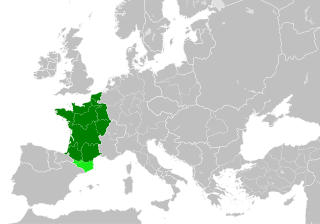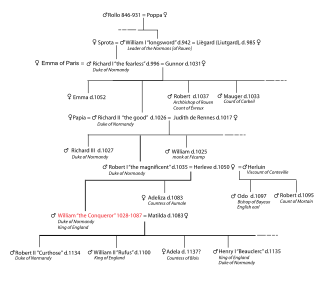
Philip II, byname Philip Augustus, was King of France from 1180 to 1223. His predecessors had been known as kings of the Franks, but from 1190 onward, Philip became the first French monarch to style himself "King of France". The son of King Louis VII and his third wife, Adela of Champagne, he was originally nicknamed Dieudonné (God-given) because he was a first son and born late in his father's life. Philip was given the epithet "Augustus" by the chronicler Rigord for having extended the crown lands of France so remarkably.

Arthur I was 4th Earl of Richmond and Duke of Brittany between 1196 and 1203. He was the posthumous son of Geoffrey II, Duke of Brittany, and Constance, Duchess of Brittany. His father, Geoffrey, was the son of Henry II, King of England.

The Duchy of Brittany was a medieval feudal state that existed between approximately 939 and 1547. Its territory covered the northwestern peninsula of Europe, bordered by the Atlantic Ocean to the west, and the English Channel to the north. It was also less definitively bordered by the river Loire to the south, and Normandy, and other French provinces, to the east. The Duchy was established after the expulsion of Viking armies from the region around 939. The Duchy, in the 10th and 11th centuries, was politically unstable, with the dukes holding only limited power outside their own personal lands. The Duchy had mixed relationships with the neighbouring Duchy of Normandy, sometimes allying itself with Normandy, and at other times, such as the Breton–Norman War, entering into open conflict.
The count of Flanders was the ruler or sub-ruler of the county of Flanders, beginning in the 9th century. Later, the title would be held for a time, by the rulers of the Holy Roman Empire and Spain. During the French Revolution, in 1790, the county of Flanders was annexed to France and ceased to exist. In the 19th century, the title was appropriated by Belgium and granted twice to younger sons of Belgian kings. The most recent holder died in 1983.

The Kingdom of France in the Middle Ages was marked by the fragmentation of the Carolingian Empire and West Francia (843–987); the expansion of royal control by the House of Capet (987–1328), including their struggles with the virtually independent principalities, and the creation and extension of administrative/state control in the 13th century; and the rise of the House of Valois (1328–1589), including the protracted dynastic crisis against the House of Plantagenet and their Angevin Empire, culminating in the Hundred Years' War (1337–1453), which laid the seeds for a more centralized and expanded state in the early modern period and the creation of a sense of French identity.

The Duchy of Normandy grew out of the 911 Treaty of Saint-Clair-sur-Epte between King Charles III of West Francia and the Viking leader Rollo. The duchy was named for its inhabitants, the Normans.

The Duchy of Burgundy emerged in the 9th century as one of the successors of the ancient Kingdom of the Burgundians, which after its conquest in 532 had formed a constituent part of the Frankish Empire. Upon the 9th-century partitions, the French remnants of the Burgundian kingdom were reduced to a ducal rank by King Robert II of France in 1004. Robert II's son and heir, King Henry I of France, inherited the duchy but ceded it to his younger brother Robert in 1032.

In the Middle Ages, the duke of Normandy was the ruler of the Duchy of Normandy in north-western France. The duchy arose out of a grant of land to the Viking leader Rollo by the French king Charles the Simple in 911. In 924 and again in 933, Normandy was expanded by royal grant. Rollo's male-line descendants continued to rule it until 1135. In 1202 the French king Philip II declared Normandy a forfeited fief and by 1204 his army had conquered it. It remained a French royal province thereafter, still called the Duchy of Normandy, but only occasionally granted to a duke of the royal house as an apanage.

The Duchy of Aquitaine was a historical fiefdom in western, central, and southern areas of present-day France to the south of the river Loire, although its extent, as well as its name, fluctuated greatly over the centuries, at times comprising much of what is now southwestern France (Gascony) and central France.
The County of Aumale, later elevated to a duchy, was a medieval fief in Normandy, disputed between France and England during parts of the Hundred Years' War.

The term Angevin Empire describes the possessions held by the House of Plantagenet during the 12th and 13th centuries, when they ruled over an area covering roughly all of present-day England, half of France, and parts of Ireland and Wales, and had further influence over much of the remaining British Isles. It may be described as an early example of a composite monarchy. The empire was established by Henry II of England, who succeeded his father Geoffrey as Duke of Normandy and Count of Anjou. Henry married Eleanor of Aquitaine in 1152, acquiring the Duchy of Aquitaine, and inherited his mother Empress Matilda's claim to the English throne, succeeding his rival Stephen in 1154. Although their title of highest rank came from the Kingdom of England, the Plantagenets held court primarily on the continent at Angers in Anjou, and at Chinon in Touraine.
The precise style of French sovereigns varied over the years. Currently, there is no French sovereign; three distinct traditions exist, each claiming different forms of title.

The War of the Public Weal was a conflict between the king of France and an alliance of feudal nobles, organized in 1465 in defiance of the centralized authority of King Louis XI of France. It was masterminded by Charles the Bold, Count of Charolais, son of the Duke of Burgundy, with the king's brother Charles, Duke of Berry, as a figurehead. The rebels succeeded in attaining concessions from the crown after several months of fighting, though conflict would break out again between the league and the crown in the Mad War of 1485 in a decisive victory for the crown.
The crown lands, crown estate, royal domain or domaine royal of France were the lands, fiefs and rights directly possessed by the kings of France. While the term eventually came to refer to a territorial unit, the royal domain originally referred to the network of "castles, villages and estates, forests, towns, religious houses and bishoprics, and the rights of justice, tolls and taxes" effectively held by the king or under his domination. In terms of territory, before the reign of Henry IV, the domaine royal did not encompass the entirety of the territory of the kingdom of France and for much of the Middle Ages significant portions of the kingdom were the direct possessions of other feudal lords.

Henry II, also known as Henry Curtmantle, was King of England from 1154 until his death in 1189. During his reign he controlled England, substantial parts of Wales and Ireland, and much of France, an area that altogether was later called the Angevin Empire, and also held power over Scotland and the Duchy of Brittany.

The Anglo-French War was a major medieval conflict that pitted the Kingdom of France against the Kingdom of England and various other states. It was fought in an attempt to curb the rising power of King Philip II of France and regain the Angevin continental possessions King John of England lost to him a decade earlier. It is widely regarded as the very first anti-French coalition war and came to an end at the decisive Battle of Bouvines at which Philip defeated England and its allies.

The Battle of Mirebeau was a battle in 1202 between the House of Lusignan-Breton alliance and the Kingdom of England. King John of England successfully smashed the Lusignan army by surprise.

The Angevin kings of England were Henry II and his sons, Richard I and John, who ruled England from 1154 to 1216. They were related to the Norman kings of England through Matilda, the daughter of Henry I and mother of Henry II. They were also related to the earlier Anglo-Saxon kings of England through Matilda's great-great-great grandfather, Aethelred the Unready. Their descendants, the main line of Plantagenets, continued to rule England until 1485; some historians make no distinction between the Angevins and the Plantagenets, while others consider John's son Henry III to be the first Plantagenet king.

The Capetian–Plantagenet rivalry was a series of conflicts and disputes that covered a period of 100 years (1159–1259) during which the House of Capet, rulers of the Kingdom of France, fought the House of Plantagenet, rulers of the Kingdom of England, over the Plantagenet-held Angevin Empire which at its peak covered around half of the territory within France. Some historians refer to this series of events as the "First Hundred Years' War".
The integration of Normandy into the royal domain of the Kingdom of France is the process of conquering and integrating the Duchy of Normandy into the domain directly under the French crown. Normandy, created in 911, was dominated by the Duke of Normandy, vassal of the King of France. This marked the beginning of a struggle between the kings of France and the dukes, the latter paying only symbolic homage to their suzerain. In 1066, William the Conqueror, then Duke of Normandy, seized the crown of England and became more powerful than the King of France. The Angevin Empire would later represent a threat to the stability of the French kingdom, which the kings of France would endeavor to break up.














